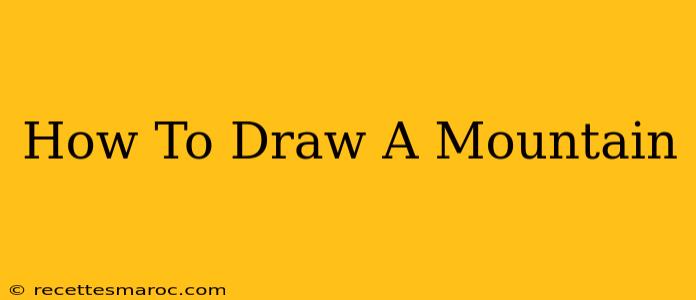Drawing mountains might seem daunting, but with a little practice and the right techniques, you can create stunning landscapes. This guide will walk you through various methods, from simple sketches to more detailed representations, catering to all skill levels. Whether you're a complete beginner picking up a pencil for the first time or an experienced artist looking to refine your mountain-drawing skills, you'll find something valuable here.
Basic Mountain Shapes: Laying the Foundation
Before diving into intricate details, let's master the fundamental shapes. Mountains, at their core, are essentially variations of triangles, cones, and rounded hills.
Step 1: The Simple Triangle Mountain
- Start with a simple triangle: Lightly sketch an isosceles triangle on your paper. This forms the basic structure of your mountain. The base will be the mountain's bottom, and the point, its peak.
- Add some irregularity: Mountains aren't perfectly symmetrical. Gently erase parts of the triangle's edges, creating uneven lines and jagged peaks. Experiment with different degrees of irregularity to achieve various mountain styles.
Step 2: Creating Depth with Overlapping Triangles
- Multiple triangles: Draw several overlapping triangles of varying sizes. This technique creates a sense of depth and perspective, suggesting that some mountains are further away than others.
- Varying heights and widths: Don't make all your triangles the same size. Varying the heights and widths adds realism and visual interest to your mountain range.
Step 3: Rounding Out the Edges for a Softer Look
- Smoothing the lines: Instead of sharp angles, soften the edges of your triangles by rounding them out. This creates a more natural and less harsh look, particularly effective for depicting rolling hills and gentler slopes.
- Adding curves: Incorporate gentle curves into the mountain's silhouette to give it a more organic feel.
Adding Detail and Realism to Your Mountain Drawing
Once you've mastered basic shapes, let's move on to adding details that will bring your mountain drawing to life.
Step 4: Incorporating Shadows and Highlights
- Light source: Identify a light source in your drawing. This will guide you in determining where to place shadows and highlights.
- Shading techniques: Use shading techniques like hatching, cross-hatching, or blending to create depth and dimension. Darker areas represent shadows, while lighter areas highlight the peaks and exposed surfaces. Experiment with different shading styles to find what best suits your artistic vision.
Step 5: Adding Texture with Lines and Patterns
- Rock formations: Use short, jagged lines to depict rocky outcrops and crevices.
- Tree lines: Indicate tree lines by adding darker patches of color or texture at lower altitudes.
- Snow caps: Add white highlights or a lighter shade to simulate snow accumulation at higher altitudes.
Step 6: Using Different Mediums for Varying Effects
Experiment with different mediums like charcoal, pastels, or colored pencils to achieve different textures and effects. Charcoal is great for creating dark, dramatic landscapes, while pastels allow for softer, blended transitions. Colored pencils provide a level of detail ideal for intricate rock formations.
Advanced Techniques for Experienced Artists
For those seeking to elevate their mountain drawing skills, here are some advanced techniques:
- Perspective drawing: Utilize perspective techniques to create a more realistic three-dimensional representation of your mountain range. Learn about vanishing points and how they affect the size and placement of your mountain features.
- Atmospheric perspective: Use lighter colors and less detail to represent mountains in the distance. This creates a sense of depth and atmosphere.
- Combining mediums: Experiment with combining different drawing mediums to create a more textured and layered effect.
Practicing and Experimenting is Key!
The key to becoming proficient at drawing mountains is consistent practice and experimentation. Don't be afraid to try different techniques, styles, and mediums. The more you draw, the better you'll become at capturing the unique beauty and majesty of mountains. So grab your pencils, and start creating your own breathtaking landscapes!

